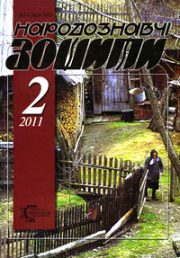The Ethnology Notebooks. 2024. № 4 (178), 793—798
UDK 811.161.2’373.21
DOI https://doi.org/10.15407/nz2024.04.793
MICROTOPONYMS IN THE TOURISM SPHERE OF THE CARPATHIANS
SOKIL-KLEPAR Nataliia
- ORCID ID: https://orcid.org/0000-0002-4156-5978
- Ph.D., Associate Professor,
- The Ukrainian Language Department named after professor Ivan Kovalyk,
- Lviv Ivan Franko National University,
- 1, Universytetska Str., 79001, Lviv, Ukraine,
- Contacts: e-mail: nsokil@ukr.net
Abstract. This article analyzes ergonyms derived from microtoponyms with various motivations (orographic, hydrographic, phytographic, etc.) used by tourist establishments in the Carpathian region.
The study’s relevance is rooted in the growing interest in ethnotourism, the increasing number of tourist facilities, and the need to preserve cultural heritage.
Theobject of study is Carpathian tourist establishments with microtoponymic etymology.
The aim is to analyze ergonyms derived from microtoponyms, identify the reasons for their choice, the normative use, and the specifics of forming such units in the ethnotouristic space of the Carpathians.
The novelty lies in viewing microtoponyms in the context of commercial nomination and identifying trends in modern ergonymy.
The chronological boundaries of the study are the beginning of the 21st century; the geographical boundaries are the territory of western Ukraine. The research methodology employs elements of descriptive and structural methods.
The study revealed that names associated with the terrain («Hora», «Osonnia», «Obіch», «Rovin»), hydrographic objects («Burkut», «Hurkalo», «Shypit») and phytogeographic objects («Bukovets», «Yavirnyk»), as well as agricultural activities («Pohar», «Pustoshak», «Tsarynka»), are the most common. Most of the microtoponyms preserved in the names of recreation facilities actually function on the territory under study (for example, the cottage «Dil», located in Krivopillya, is named on the basis of the real mount Dil in this area). Particular attention is paid to issues of the normative use of microtoponymic ergonyms as well as the influence of linguistic and cultural factors on the naming process.
Conclusion: Overall, microtoponyms play a significant role in shaping the brand of a tourist establishment, providing it with uniqueness and authenticity. At the same time, the use of microtoponyms for commercial purposes requires a responsible approach to preserve cultural and national values and adhere to the norms of the Ukrainian language.
Keywords: microtoponym, ergonym, ethnotourism, Carpathians, commercial nomination, onomastics.
Received 29.07.2024
REFERENCES
- Orlova, M.L. (2009). Ethnic tourism resources of the region: socio-geographic assessment (based on the materials of Odesa region): autoref. thesis … candidate geogr. sciences: 11.00.02 «Economic and special geography». Odesa [in Ukrainian].
- Retrieved from: https://www.karpaty.info/ua/ [in Ukrainian].
- Chaplinskyi, B., & Kibych, A. (2010). Problems of the ethno-cultural landscape of the Hutsul region: features, division, preservation. Scientific notes of Vinnytsia Pedagogical University. «Geography» series (Issue 21, pp. 259—265) [in Ukrainian].
- Tepla, O.M. (2012). Linguistic concept of creating a commercial nomination. Bulletin of the Dnipropetrovsk University named after Alfred Nobel. Series «Philological Sciences», 1 (3), 192—195 [in Ukrainian].
- Teletov, O.S, & Teletova, S.Н. (2021). Naming in the communication management system: marketing and linguistic aspects. European scientific discussions: abstracts of the 5th International scientific and practical conference. Potere della ragione Editore (Pp. 620—627). Rome, Italy [in Ukrainian].
- Buchko, D.H., & Tkachova, N.V. (2012). Dictionary of Ukrainian onomastic terminology. Kharkiv: Ranok-NT [in Ukrainian].
- Zymovets, Н.V. (2009). Structural and semantic peculiarities of ergonyms of Ukraine. Bulletin of Dnipropetrovsk University. Series «Linguistics» (Issue 15, vol. 3, pp. 33—41) [in Ukrainian].
- Haborak, M. (2008). Names of mountains and valleys of Ivano-Frankivsk region. Dictionary-reference. Ivano-Frankivsk: City of NV [in Ukrainian].
- Нaborak, M. (2011). Toponymy of the Galician Hutsul region. Etymological dictionary-reference. Ivano-Frankivsk: City of NV [in Ukrainian]. Beley, O. (1999). Modern Ukrainian ergonomics: Proper names of enterprises in Transcarpathia. Uzhhorod [in Ukrainian].






